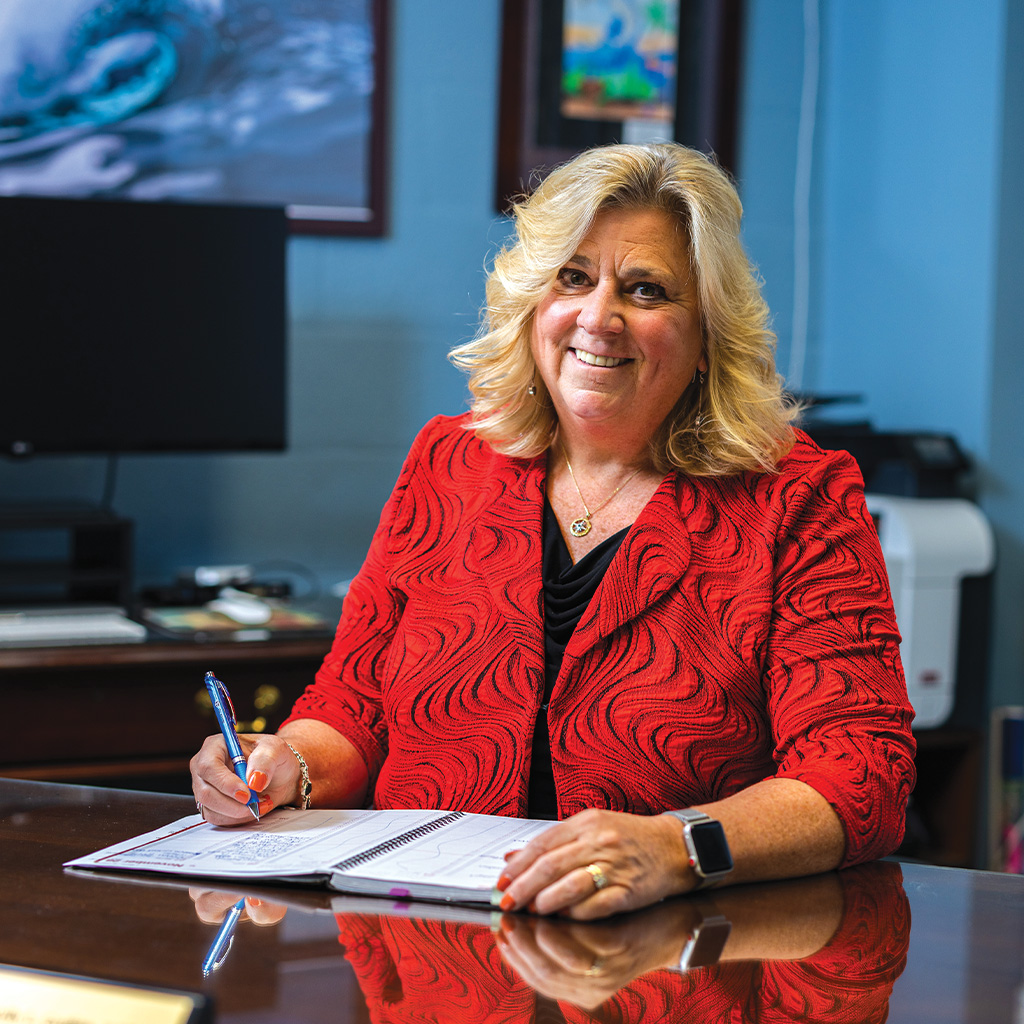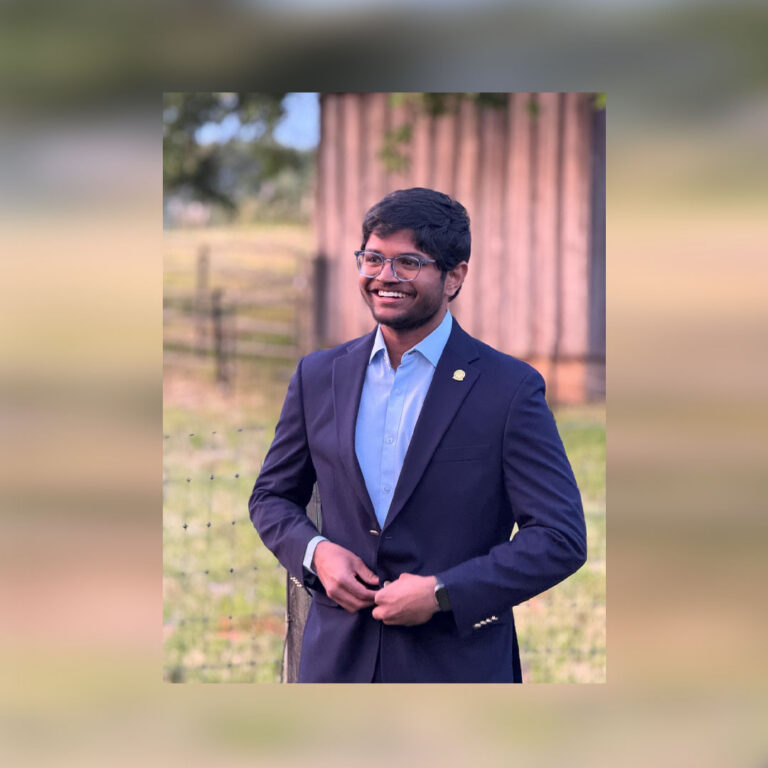Dr. Kelly Griffith: Maryland’s Superintendent of the Year

Steering the massive ship of a school system through the heaving seas of the last few years, including the pandemic, has required a number of unique skills and abilities that only come from years of experience and training.
For Dr. Kelly Griffith, Wil-mington University alumna and superintendent of Talbot County Schools on Maryland’s Mid Shore, this has meant using every ounce of experience gained over 38 years as an educator and leader to keep her ship upright and sailing true, despite teacher and staff shortages, the sudden change to virtual learning, addressing technology gaps and limits, and more.
So, it certainly came as a happy surprise to learn the county’s Board of Education members and her colleagues nominated her late last year as Maryland Superintendent of the Year, awarded through the Public School Superintendents’ Association of Maryland. As the winner for Maryland, which has 25 school districts, she is set to represent the state in the National Superintendent of the Year competition in spring of 2022.
Dr. Griffith has been superintendent for nine years. She started as a teacher in the county in 1988, and continued to move up in leadership positions, first as a teacher and later as an administrator. Her career planning meant earning a doctorate, so she chose WilmU’s Educational Leadership and Innovation education program. She also holds a master’s in Educational Administration and a bachelor’s degree from Salisbury University, where she’s an adjunct instructor.
But even holding the top leadership position in the public school district in recent years has not meant leaving her passion behind. Her priorities are still focused on doing what’s best for students and how professionals can best serve them.
“It’s all about relationships and paying attention to each individual child,” she explains. “What are their needs?”
Looking for ways to meet those needs means making changes. For example, Dr. Griffith notes a possible need for greater flexibility in delivering instruction for students who might need to work during the day and learn at night.
“Guess what?” she says. “We can make that work.”
The public school system needs to explore changing some practices, she says. “We need to change with the changing times, and that doesn’t always happen in public education.”
With so many urgent needs vying for her attention, Dr. Griffith says retention of high school students — specifically reducing dropout rates in her district and increasing college readiness — are high on her list of action items.
“When I got the job as superintendent, we started strategic planning, and our graduation rate was about 85%, and our dropout rate was 10%,” she explains. But with several changes, “Now our graduation rate is 96%, and our dropout rate is less than 2%.”
These actions largely stem from results gathered during Dr. Griffith’s dissertation, a qualitative study on students’ perspectives of their readiness for college. For her research, she interviewed students after they had graduated and had not taken a dual enrollment or an AP course, but who had gone on to two- or four-year colleges. She then interviewed them after their freshman years.
Working on the dissertation was “the highlight of the whole program,” she says. “The courses were great. I loved my cohort, but when you really sit down and talk with students, and you love education as much as I do, and in making a difference, that to me was really a powerful qualitative study.”
Her goal with the study, Dr. Griffith says, “was to find out a bit more about how the public school system could have helped them transition and why they didn’t take college courses.” The reasons were varied. “A lot of students would say that people didn’t see them as college material, so they weren’t encouraged,” she adds. “Others said they found a mentor in the building, and that mentor helped.” So, using the data, “We’ve tightened up our counseling and our transitioning since then, and did institute some mentorships of our seniors since that study,” she adds.
In the last year-and-a-half during COVID-19 disruptions, Dr. Griffith says the school system made it through those changes in better shape than others elsewhere.
Before the restrictions, the school system had a one-to-one computing initiative, with students receiving laptops to complete schoolwork.
“We had a device for students from first grade to 12, and our secondary students from sixth grade through 12th grade took their devices home every night. Elementary had one in the classroom,” Dr. Griffith says.
Now our graduation rate is 96%, and our dropout rate is less than 2%.”
That was a massive hurdle that many school systems couldn’t jump. “We were able to use some of the funds that we got from the federal government to buy devices for kindergarten and pre-K,” she says. “One of the biggest hurdles was connectivity.”
Some families couldn’t afford it, but other challenges were related to the rural nature of the county and its large digital voids.
“We quickly got together with our local cable companies, and we wrote a grant to get some hotspots so we could get those in place,” she says. The local utility company provided a discount to families, and the district picked up the cable costs.
“I know we shut down March 13, 2020, and we were only going to be closed a week, then two weeks, then three weeks. But we were able to really, truly pivot quickly when it came to getting our kids set up with getting the devices out, making sure hotspots were getting in the hands of kids, getting people connected.”
Connectivity remains a problem, whether it’s cost or connection. Once the new school year began, the district planned for virtual and in-person learning.
“We found out a third of our students wanted to be virtual,” she says. “We decided the best way to do that for elementary and middle school was to have virtual teachers as opposed to concurrent teaching. We decided which teachers would be virtual teachers and which would be in person.”
This succeeded quite well. “We actually had our students in more days than most counties in the state. And I think it was because we did a lot of planning — very intentional planning with a lot of feedback from the community.”
Dr. Griffith emphasizes that planning is an essential part of the job. A five-year strategic plan has just ended, but a new one called Strive for 25 addresses issues like the teacher shortage, new curriculum, expanding career and technology programs, and other needs.
“A big part of “Strive for 25” is going to be thinking differently about how we provide education and opportu-nities for students,” she explains.
One of her favorite activities is visiting schools and walking the halls, checking in with teachers and substitutes to ask about their day. One day, a little boy asked her, “Dr. Griffith, what is your job? We see you all the time.”
Griffith replied, “Just like the school principal is in charge of making sure all teachers have what they need and that the buses run on time, just to make sure it runs smoothly, that’s what I do for the whole district. The student looked at me and said, ‘Wow, you must be a millionaire.’ And I said, no, not quite. Then he said, ‘That’s amazing.’ I said, yeah, it is. But it’s also very rewarding because I get to talk to kids like you and find out how you’re doing.”
by Janice Colvin



